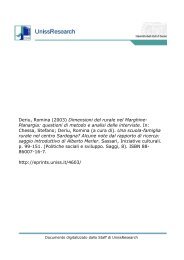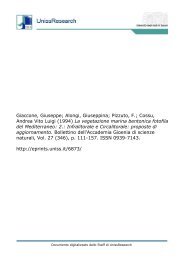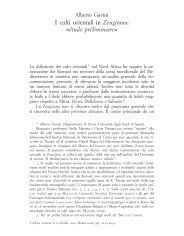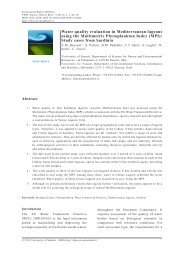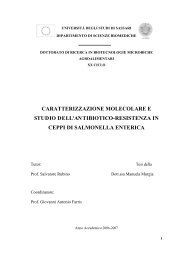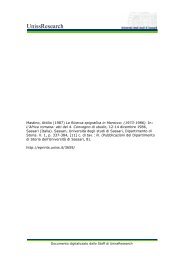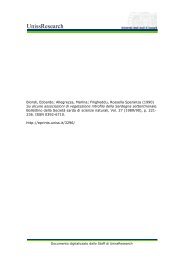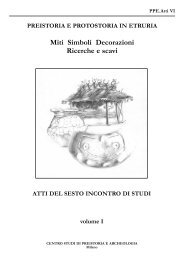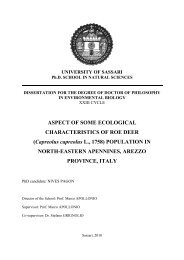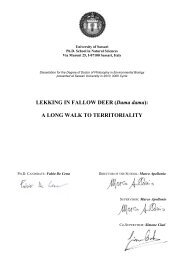L'Africa romana - UnissResearch - Università degli Studi di Sassari
L'Africa romana - UnissResearch - Università degli Studi di Sassari
L'Africa romana - UnissResearch - Università degli Studi di Sassari
You also want an ePaper? Increase the reach of your titles
YUMPU automatically turns print PDFs into web optimized ePapers that Google loves.
98 Jesper Carlsen<br />
important entrusted slave of wealthy Roman families, but, to my knowledge,<br />
no regional survey inclu<strong>di</strong>ng the private superintendents has hitherto<br />
been attempted. The African provinces, with more than twenty<br />
<strong>di</strong>spensatores attested, represent an excellent field for such an inquiry<br />
that will be complementary to the reference books in some respects 4 •<br />
This paper will therefore first <strong>di</strong>scuss some regional peculiari ti es of the<br />
African <strong>di</strong>spensatores, but it will concentrate on their functions, since<br />
the often neglected inscriptions of <strong>di</strong>spensatores contain important information<br />
on the relations between the groups involved in the administration<br />
and management of the imperial possessions in Roman North<br />
Africa.<br />
One point of special interest is the age of the imperial <strong>di</strong>spensatoreso<br />
Weaver assumed that these were normal1y manumitted about the age<br />
of forty or soon after, but this is not corroborated by the African inscriptions<br />
with age-declarations. Disregar<strong>di</strong>ng twoJJrivate <strong>di</strong>spensatores<br />
aged respectively 46 and 79, only one imperial agent seems to have had<br />
the proper age. The other inscriptions attest much higher ages than forty,<br />
although a 110-year-old <strong>di</strong>spensator legionis III Augustae must surely<br />
be an exaggeration.5. Yet the value of these scattered inscriptions can<br />
only ben in<strong>di</strong>cative. Successful <strong>di</strong>spensatores were promoted to seni or<br />
clerical positions of tabularii and procuratores with the status as freedmen,<br />
and the age-declarations of the so-caIIed vicarii of <strong>di</strong>spensatores<br />
in fact support the tenabiIity of Weaver's observations. A vicarius could<br />
be the personal slave of another slave, but the use of the term among<br />
the imperial slaves is so closely associated with financial officials that<br />
it must be regarded as a technical term for deputies of slave officials.<br />
When a <strong>di</strong>spensator advanced, retired or was manumitted, the younger<br />
vicarius normally replaced him, and the recorded ages of vicarii from<br />
Roman North Africa (i.e. 26, 32 and 40) fit this supposed habit very<br />
we11 6 •<br />
4 CIL VIII 1028,3288,3289,3291,9755, 10572, 12892, 13341, 15594, 17051, 17335,<br />
20589,21012,24687,27550 = AE 1899 no. 41, AE 1915 no. 20, AE 1932 no. 15, AE 1942/43<br />
no. 60, AE 1957 no. 86, AE 1969170 no. 664, AE 1972 no. 717, AE 1980 no. 966 and<br />
«Africa», X, 1988,209. Dispensarores also appear on the stamp of an opus doliare from<br />
the imperial prae<strong>di</strong>a Stato1liensia found in Carthage, but this estate was located in Italy:<br />
CIL VIII 22632,6 = XV 541. The fragmented CIL VIII 17510 = ILA 469 must be excluded,<br />
since the proposed <strong>di</strong>sp in CIL rather should be read as <strong>di</strong>sen.<br />
s WEAVER (1972), 206 and 226, but see also BOULVERT (1974), ISO. Private: CIL VIII<br />
15594, 20589. Imperial <strong>di</strong>spensatores: CIL VIII 1028, 3289 and 12892.<br />
6 WEAVER (1972), 2()()"206, but see also the stili fundamental H. ERMAN Servus vicarills,<br />
Lausanne 1896. CIL VIII 17335, AE 1942/43 no. 60 and AE 1969;70 no. 664.<br />
Dispensatores in Roman Norrh Ajrica<br />
Another point is recruitment. The majority of the African <strong>di</strong>spensatores<br />
caH themselves vernae, a term normaIIy denoting home-born slaves.<br />
Weaver has demonstrated that the term is also employed to in<strong>di</strong>cate personal<br />
slaves of imperial slaves and freedmen who <strong>di</strong>ed earIy, but in connection<br />
with the African <strong>di</strong>spensatores verna seems to be used exclusively<br />
for home-born slaves 7 • Relations of quasi-adoption, however, are attested<br />
by three epitaphs put up by imperial <strong>di</strong>spensatores to commemorate alumni.<br />
One was a five-year-old slave boy and the two others were adult womeno<br />
One of the latter was al so a slave, but Aurelia Karica was apparcnt<br />
Iy an imperial freedwoman 8 • Other epitaphs reveal more regular nuclear<br />
families as they attest both chiIdren of imperial <strong>di</strong>spensatores and coniugi,<br />
the latter being slaves too or else freed women or pcrhaps even freeborn.<br />
\Ve must assume that in some cases thc wife was manumitted before thc<br />
husband who had his manumission delayed because of his post as<br />
<strong>di</strong>spensator 9 • But the mixed marriages between slaves and freeborn women<br />
also reflect the sodal mobility and position of thc <strong>di</strong>spensa/ores due<br />
to the importance of their tasks in the imperial administration.<br />
Tlle functions oJ tlle <strong>di</strong>spensatores<br />
At least one, and perhaps even more, of the <strong>di</strong>spensatores in the African<br />
provinces <strong>di</strong>d not belong to thefamilia Caesaris. At Hammam Said<br />
near the famous saltus Burunitanus the <strong>di</strong>spensator Datosus and his wife,<br />
Paccia Iustina, raised an epitaph to commemorate their twenty-monthold<br />
son:<br />
D(is) M(anibus) S(acrum).1 C(aius) lulius Hilarus I pius vixit<br />
annoi uno m(ensibus) VIII d(iebus) XXVII. I Datosus<br />
<strong>di</strong>sp(ensator) et I Paccia Iustina I parentesfilio I dulcissimo<br />
fec(erunt)./ H(ic) s(itus) e(st).<br />
7 African vcrnae: CIL VIII 3288, 3289, 12892, 15594,27550, AE 1915 no. 20, AE<br />
1932 no. 15, AE 1957 no. 86 and «Africa» X, 1988, 209. WEAVER (1972), 207-211, and<br />
in generai: H.S. NIELSEN, Diti'ì examen domus. On rhe Use oj the Term 'verna' in rhe Roman<br />
Epigraphical and Literary Sources, «C&M» 42, 1991, 221-240.<br />
8 C/L VIII 3288: D(is) M(anibus) S(acrum).! Aureliae Karicae 1 alumnae \'(ixit)<br />
a(nnis) XXXII.! Adventus A ug (usti) 1 vern(a) <strong>di</strong>sp(ensator)1 leg(ionis) /11 Aug(ustae). The<br />
complete texts of elL VIII 24687 and «Africa», X, 1988, 209, are gi\'en in notes 9 and<br />
13. For the term see BOULVERT (1974),325-328, H.S. NIELSEN, Alumnus: A Term Dj Relalion<br />
Denoting Quasi-Adoption, «C&M», 38, 1987, 141-188, and M. CORDlER, Usages<br />
publics du vocabulaire de la parenté: patronus et alumnus de la ciré dans l'Afrique romaine,<br />
Africa Romana, 7, 1990, 815-854.<br />
9 C/L VIII 10572, 12892, 17051, 17335 and 27550. See WEAVER (1972), 115-116 and<br />
204-205, but also BOULVERT (1974), 300-328.<br />
99



